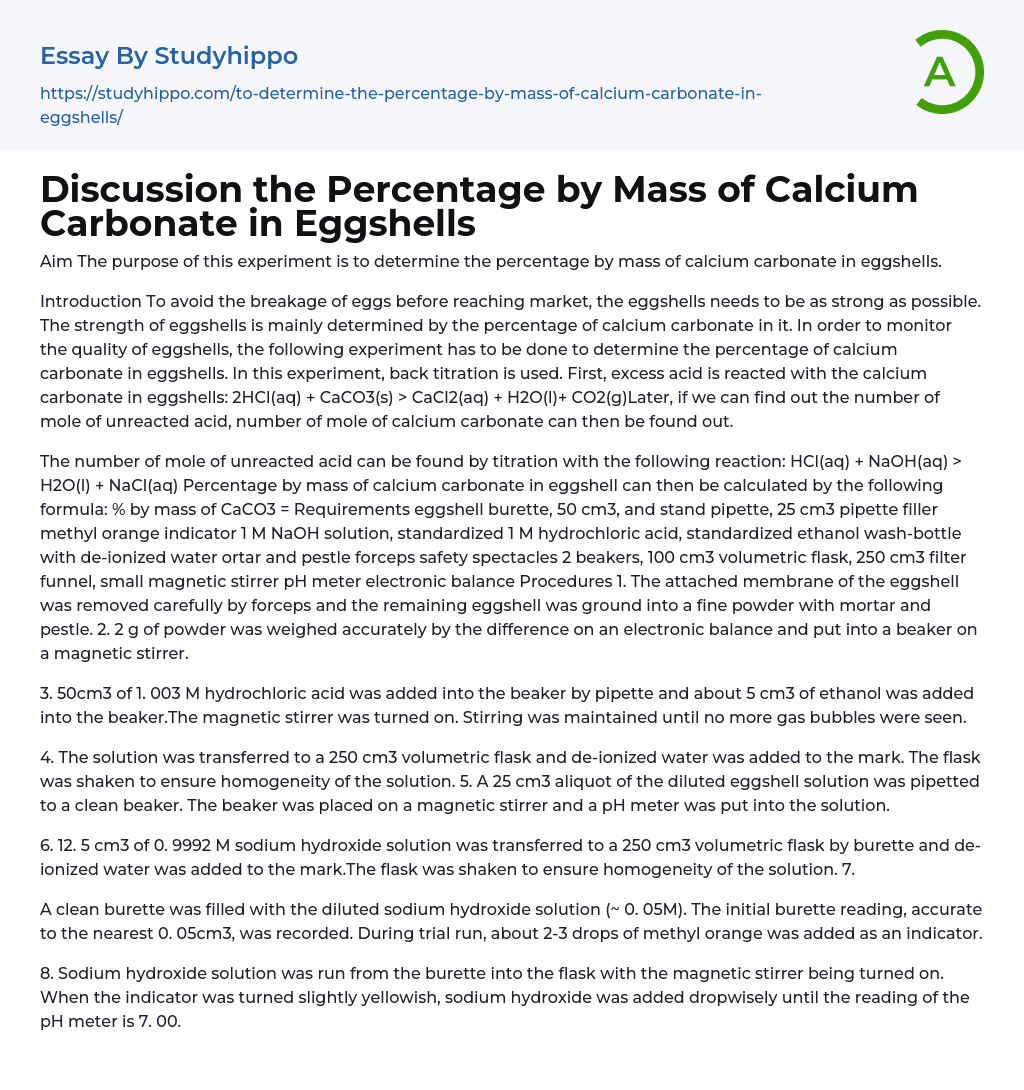

Discussion the Percentage by Mass of Calcium Carbonate in Eggshells Essay Example
Aim The purpose of this experiment is to determine the percentage by mass of calcium carbonate in eggshells.
Introduction To avoid the breakage of eggs before reaching market, the eggshells needs to be as strong as possible. The strength of eggshells is mainly determined by the percentage of calcium carbonate in it. In order to monitor the quality of eggshells, the following experiment has to be done to determine the percentage of calcium carbonate in eggshells. In this experiment, back titration is used. First, excess acid is reacted with the calcium carbonate in eggshells: 2HCl(aq) + CaCO3(s) > CaCl2(aq) + H2O(l)+ CO2(g)Later, if we can find out the number of mole of unreacted acid, number of mole of calcium carbonate can then be found out.
The number of mole of unreacted acid can be found by titration with the following reaction: HCl(aq) + NaOH(aq)
...> H2O(l) + NaCl(aq) Percentage by mass of calcium carbonate in eggshell can then be calculated by the following formula: % by mass of CaCO3 = Requirements eggshell burette, 50 cm3, and stand pipette, 25 cm3 pipette filler methyl orange indicator 1 M NaOH solution, standardized 1 M hydrochloric acid, standardized ethanol wash-bottle with de-ionized water ortar and pestle forceps safety spectacles 2 beakers, 100 cm3 volumetric flask, 250 cm3 filter funnel, small magnetic stirrer pH meter electronic balance
Procedures
- The attached membrane of the eggshell was removed carefully by forceps and the remaining eggshell was ground into a fine powder with mortar and pestle.
- 2 g of powder was weighed accurately by the difference on an electronic balance and put into a beaker on a magnetic stirrer.
- 50cm3 of 1. 003 M hydrochloric
acid was added into the beaker by pipette and about 5 cm3 of ethanol was added into the beaker.The magnetic stirrer was turned on. Stirring was maintained until no more gas bubbles were seen.
The final burette reading, accurate to the nearest 0. 05cm3, was recorded. . The burette was refilled with the diluted sodium hydroxide solution. Steps 7 and 8 were repeated 3 times without using indicator. Sodium hydroxide was added dropwisely when the burette reading was close to the final reading in trial run.
Diagram Results Tables Trial123 Burette reading / cm3Final26. 8026. 8526. 8026. 75
Initial0. 000. 000.
000. 00 Volume used (titre) / cm326. 8026. 8526. 8026. 75 Mean titre / cm326. 80
Calculation The number of moles of NaOH used in each titration = 26. 80/1000 dm3 ? 0. 05 M = 1. 34 ? 10-3 mol
According to the equation: HCl(aq) + NaOH(aq) > H2O(l) + NaCl(aq) mole of NaOH will react with 1 mole of HCl.
Therefore, 1. 34 ? 10-3 mole of HCl was used in the reaction.
However, the solution was diluted by 10 times. Therefore, number of mole of HCl left after the reaction with CaCO3 = 1. 34 ? 10-3 ? 10 = 0. 0134 mol Number of mole of HCl added = 50/1000 dm3 ? 1. 003 M = 0. 05015 mol Number of mole of HCl used to react with CaCO3 in eggshells = 0. 05015 – 0. 0134 =0. 03675 mol According to the equation: 2HCl(aq) + CaCO3(s) > CaCl2(aq) + H2O(l)+ CO2(g) 2 mole of HCl will react with 1 mole of CaCO3.
Therefore, 0. 018375 mole of CaCO3 was used in the reaction.Mass of CaCO3 used = 0. 018375 ? (40. 1 + 12 + 16 ? 3) = 1. 855875g Therefore, percentage by mass of CaCO3 in eggshells = 1. 855875g/2. 00g ? 100 % = 92. 8 % Conclusion The percentage by mass of calcium carbonate in eggshells is determined to be 92. 8 %.
Discussion
- Calcium carbonate may not react with acid with a very fast rate. Therefore, enough acid should be added overnight or the eggshell should be ground into a very fine powder to ensure that all calcium carbonate can be reacted.
- After the reaction of calcium carbonate with hydrochloric
acid, carbon dioxide is formed.The carbon dioxide may affect the experiment. It is because the bubbles of carbon dioxide may cause trouble while diluting the solution into 250 cm3. Moreover, some carbon dioxide may dissolve into the solution and may affect the result. To get rid of carbon dioxide, boiling of the solution may help.
As 0. 04996 M is very close to 0.05 M. The difference of the two molarities is so small that it is negligible. Moreover, the error in the dilution may lead to this difference. Therefore, 0. 05 M was taken as its molarity in the calculation.
v
- John Locke essays
- 9/11 essays
- A Good Teacher essays
- A Healthy Diet essays
- A Modest Proposal essays
- A&P essays
- Academic Achievement essays
- Achievement essays
- Achieving goals essays
- Admission essays
- Advantages And Disadvantages Of Internet essays
- Alcoholic drinks essays
- Ammonia essays
- Analytical essays
- Ancient Olympic Games essays
- APA essays
- Arabian Peninsula essays
- Argument essays
- Argumentative essays
- Art essays
- Atlantic Ocean essays
- Auto-ethnography essays
- Autobiography essays
- Ballad essays
- Batman essays
- Binge Eating essays
- Black Power Movement essays
- Blogger essays
- Body Mass Index essays
- Book I Want a Wife essays
- Boycott essays
- Breastfeeding essays
- Bulimia Nervosa essays
- Business essays
- Business Process essays
- Canterbury essays
- Carbonate essays
- Catalina de Erauso essays
- Cause and Effect essays
- Cesar Chavez essays
- Character Analysis essays
- Chemical Compound essays
- Chemical Element essays
- Chemical Substance essays
- Cherokee essays
- Cherry essays
- Childhood Obesity essays
- Chlorine essays
- Classification essays
- Cognitive Science essays



